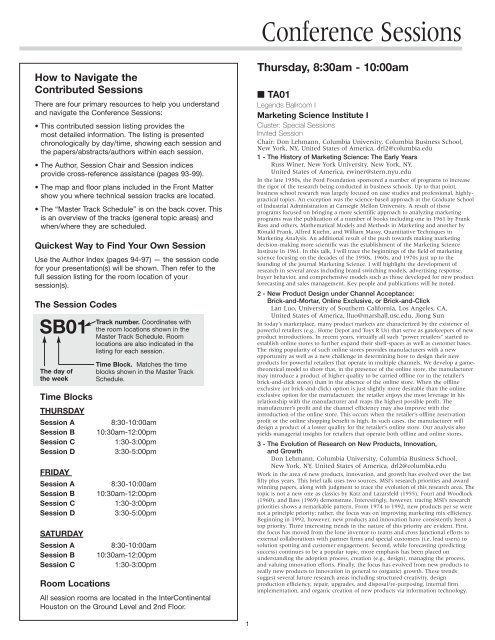2012 INFORMS Marketing Science Conference June 7
2012 INFORMS Marketing Science Conference June 7
2012 INFORMS Marketing Science Conference June 7
You also want an ePaper? Increase the reach of your titles
YUMPU automatically turns print PDFs into web optimized ePapers that Google loves.
How to Navigate the<br />
Contributed Sessions<br />
There are four primary resources to help you understand<br />
and navigate the <strong>Conference</strong> Sessions:<br />
This contributed session listing provides the<br />
most detailed information. The listing is presented<br />
chronologically by day/time, showing each session and<br />
the papers/abstracts/authors within each session.<br />
The Author, Session Chair and Session indices<br />
provide cross-reference assistance (pages 93-99).<br />
The map and floor plans included in the Front Matter<br />
show you where technical session tracks are located.<br />
The “Master Track Schedule” is on the back cover. This<br />
is an overview of the tracks (general topic areas) and<br />
when/where they are scheduled.<br />
Quickest Way to Find Your Own Session<br />
Use the Author Index (pages 94-97) — the session code<br />
for your presentation(s) will be shown. Then refer to the<br />
full session listing for the room location of your<br />
session(s).<br />
The Session Codes<br />
SB01<br />
The day of<br />
the week<br />
Time Blocks<br />
THURSDAY<br />
Session A 8:30-10:00am<br />
Session B 10:30am-12:00pm<br />
Session C 1:30-3:00pm<br />
Session D 3:30-5:00pm<br />
FRIDAY<br />
Session A 8:30-10:00am<br />
Session B 10:30am-12:00pm<br />
Session C 1:30-3:00pm<br />
Session D 3:30-5:00pm<br />
SATURDAY<br />
Track number. Coordinates with<br />
the room locations shown in the<br />
Master Track Schedule. Room<br />
locations are also indicated in the<br />
listing for each session.<br />
Time Block. Matches the time<br />
blocks shown in the Master Track<br />
Schedule.<br />
Session A 8:30-10:00am<br />
Session B 10:30am-12:00pm<br />
Session C 1:30-3:00pm<br />
Room Locations<br />
All session rooms are located in the InterContinental<br />
Houston on the Ground Level and 2nd Floor.<br />
1<br />
<strong>Conference</strong> Sessions<br />
Thursday, 8:30am - 10:00am<br />
■ TA01<br />
Legends Ballroom I<br />
<strong>Marketing</strong> <strong>Science</strong> Institute I<br />
Cluster: Special Sessions<br />
Invited Session<br />
Chair: Don Lehmann, Columbia University, Columbia Business School,<br />
New York, NY, United States of America, drl2@columbia.edu<br />
1 - The History of <strong>Marketing</strong> <strong>Science</strong>: The Early Years<br />
Russ Winer, New York University, New York, NY,<br />
United States of America, rwiner@stern.nyu.edu<br />
In the late 1950s, the Ford Foundation sponsored a number of programs to increase<br />
the rigor of the research being conducted in business schools. Up to that point,<br />
business school research was largely focused on case studies and professional, highlypractical<br />
topics. An exception was the science-based approach at the Graduate School<br />
of Industrial Administration at Carnegie Mellon University. A result of those<br />
programs focused on bringing a more scientific approach to analyzing marketing<br />
programs was the publication of a number of books including one in 1961 by Frank<br />
Bass and others, Mathematical Models and Methods in <strong>Marketing</strong> and another by<br />
Ronald Frank, Alfred Kuehn, and William Massy, Quantitative Techniques in<br />
<strong>Marketing</strong> Analysis. An additional result of the push towards making marketing<br />
decision-making more scientific was the establishment of the <strong>Marketing</strong> <strong>Science</strong><br />
Institute in 1961. In this talk, I will trace the beginnings of the field of marketing<br />
science focusing on the decades of the 1950s, 1960s, and 1970s just up to the<br />
founding of the journal <strong>Marketing</strong> <strong>Science</strong>. I will highlight the development of<br />
research in several areas including brand switching models, advertising response,<br />
buyer behavior, and comprehensive models such as those developed for new product<br />
forecasting and sales management. Key people and publications will be noted.<br />
2 - New Product Design under Channel Acceptance:<br />
Brick-and-Mortar, Online Exclusive, or Brick-and-Click<br />
Lan Luo, University of Southern California, Los Angeles, CA,<br />
United States of America, lluo@marshall.usc.edu, Jiong Sun<br />
In today’s marketplace, many product markets are characterized by the existence of<br />
powerful retailers (e.g., Home Depot and Toys R Us) that serve as gatekeepers of new<br />
product introductions. In recent years, virtually all such “power retailers” started to<br />
establish online stores to further expand their shelf-spaces as well as customer bases.<br />
The rising popularity of such online stores provides manufacturers with a new<br />
opportunity as well as a new challenge in determining how to design their new<br />
products for powerful retailers that operate in multiple channels. We develop a gametheoretical<br />
model to show that, in the presence of the online store, the manufacturer<br />
may introduce a product of higher quality to be carried offline (or in the retailer’s<br />
brick-and-click stores) than in the absence of the online store. When the offline<br />
exclusive (or brick-and-click) option is just slightly more desirable than the online<br />
exclusive option for the manufacturer, the retailer enjoys the most leverage in his<br />
relationship with the manufacturer and reaps the highest possible profit. The<br />
manufacturer’s profit and the channel efficiency may also improve with the<br />
introduction of the online store. This occurs when the retailer’s offline reservation<br />
profit or the online shopping benefit is high. In such cases, the manufacturer will<br />
design a product of a lower quality for the retailer’s online store. Our analysis also<br />
yields managerial insights for retailers that operate both offline and online stores.<br />
3 - The Evolution of Research on New Products, Innovation,<br />
and Growth<br />
Don Lehmann, Columbia University, Columbia Business School,<br />
New York, NY, United States of America, drl2@columbia.edu<br />
Work in the area of new products, innovation, and growth has evolved over the last<br />
fifty plus years. This brief talk uses two sources, MSI’s research priorities and award<br />
winning papers, along with judgment to trace the evolution of this research area. The<br />
topic is not a new one as classics by Katz and Lazarsfeld (1955), Fourt and Woodlock<br />
(1960), and Bass (1969) demonstrate. Interestingly, however, tracing MSI’s research<br />
priorities shows a remarkable pattern. From 1974 to 1992, new products per se were<br />
not a principle priority; rather, the focus was on improving marketing mix efficiency.<br />
Beginning in 1992, however, new products and innovation have consistently been a<br />
top priority. Three interesting trends in the nature of this priority are evident. First,<br />
the focus has moved from the lone inventor to teams and cross functional efforts to<br />
external collaborations with partner firms and special customers (i.e. lead users) to<br />
solution spotting and customer engagement. Second, while forecasting (predicting<br />
success) continues to be a popular topic, more emphasis has been placed on<br />
understanding the adoption process, creation (e.g., design), managing the process,<br />
and valuing innovation efforts. Finally, the focus has evolved from new products to<br />
really new products to innovation in general to (organic) growth. These trends<br />
suggest several future research areas including structured creativity, design<br />
production efficiency, repair, upgrades, and disposal/re-purposing, internal firm<br />
implementation, and organic creation of new products via information technology.

















